Analyzing Apple Inc.'s Global Supply Chain Challenges and Solutions
VerifiedAdded on 2023/03/17
|6
|1455
|74
Report
AI Summary
This report examines Apple Inc.'s global supply chain challenges, specifically the lack of physical presence in third-world countries like Nigeria. The analysis highlights the problem of high product prices due to reliance on independent distributors and expensive shipping. The report identifies distribution and delivery as key areas for improvement, proposing solutions such as establishing Apple stores and utilizing merchandising strategies to increase market reach and profitability. The author recommends merchandising as the most viable solution, emphasizing its cost-effectiveness and potential for rapid expansion. The report concludes with a call for Apple Inc. to prioritize customer access and tailor strategies to reach all potential customers.

Running head: SUPPLY CHAIN 1
Supply Chain
Student’s Name
Institution
Date
Supply Chain
Student’s Name
Institution
Date
Paraphrase This Document
Need a fresh take? Get an instant paraphrase of this document with our AI Paraphraser
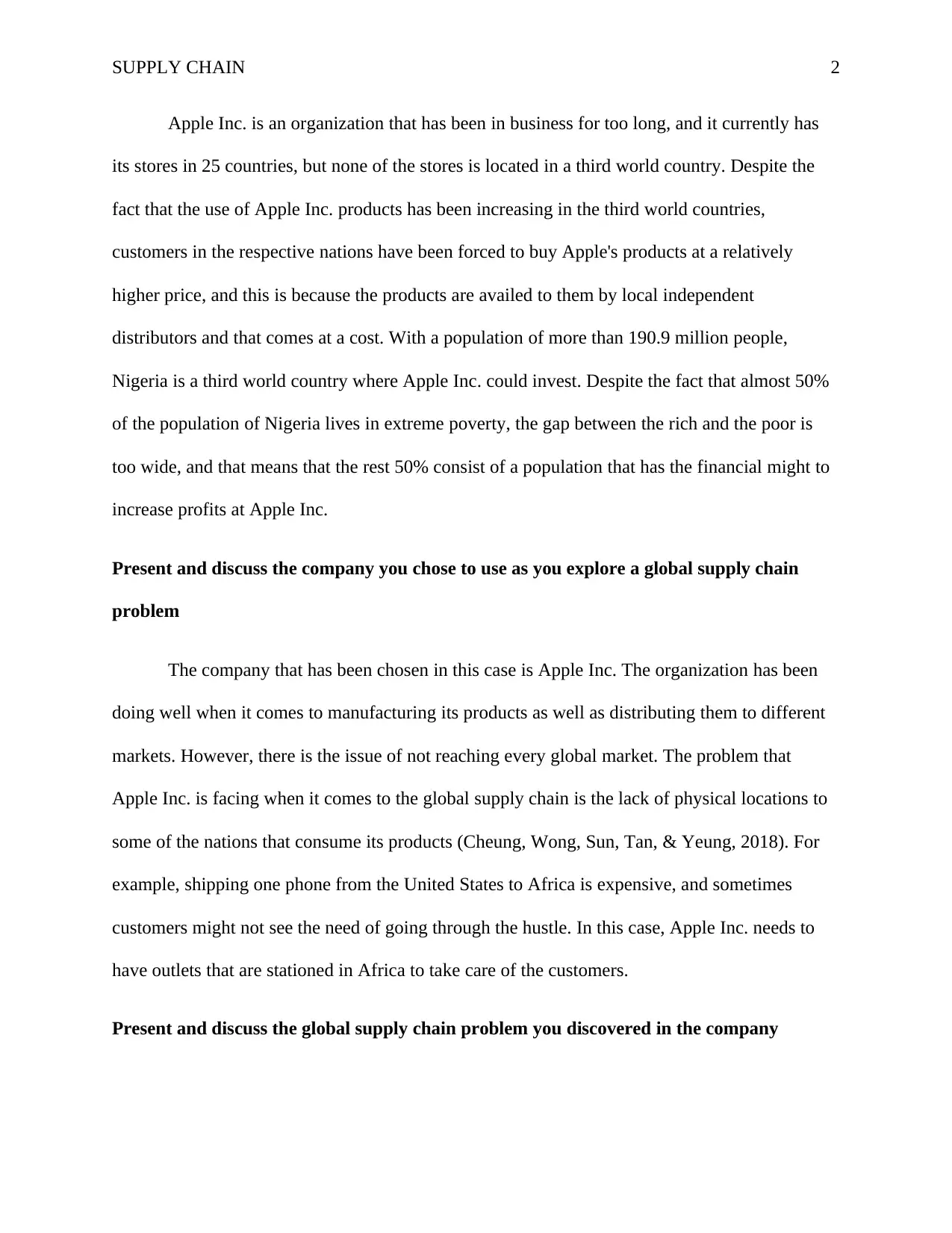
SUPPLY CHAIN 2
Apple Inc. is an organization that has been in business for too long, and it currently has
its stores in 25 countries, but none of the stores is located in a third world country. Despite the
fact that the use of Apple Inc. products has been increasing in the third world countries,
customers in the respective nations have been forced to buy Apple's products at a relatively
higher price, and this is because the products are availed to them by local independent
distributors and that comes at a cost. With a population of more than 190.9 million people,
Nigeria is a third world country where Apple Inc. could invest. Despite the fact that almost 50%
of the population of Nigeria lives in extreme poverty, the gap between the rich and the poor is
too wide, and that means that the rest 50% consist of a population that has the financial might to
increase profits at Apple Inc.
Present and discuss the company you chose to use as you explore a global supply chain
problem
The company that has been chosen in this case is Apple Inc. The organization has been
doing well when it comes to manufacturing its products as well as distributing them to different
markets. However, there is the issue of not reaching every global market. The problem that
Apple Inc. is facing when it comes to the global supply chain is the lack of physical locations to
some of the nations that consume its products (Cheung, Wong, Sun, Tan, & Yeung, 2018). For
example, shipping one phone from the United States to Africa is expensive, and sometimes
customers might not see the need of going through the hustle. In this case, Apple Inc. needs to
have outlets that are stationed in Africa to take care of the customers.
Present and discuss the global supply chain problem you discovered in the company
Apple Inc. is an organization that has been in business for too long, and it currently has
its stores in 25 countries, but none of the stores is located in a third world country. Despite the
fact that the use of Apple Inc. products has been increasing in the third world countries,
customers in the respective nations have been forced to buy Apple's products at a relatively
higher price, and this is because the products are availed to them by local independent
distributors and that comes at a cost. With a population of more than 190.9 million people,
Nigeria is a third world country where Apple Inc. could invest. Despite the fact that almost 50%
of the population of Nigeria lives in extreme poverty, the gap between the rich and the poor is
too wide, and that means that the rest 50% consist of a population that has the financial might to
increase profits at Apple Inc.
Present and discuss the company you chose to use as you explore a global supply chain
problem
The company that has been chosen in this case is Apple Inc. The organization has been
doing well when it comes to manufacturing its products as well as distributing them to different
markets. However, there is the issue of not reaching every global market. The problem that
Apple Inc. is facing when it comes to the global supply chain is the lack of physical locations to
some of the nations that consume its products (Cheung, Wong, Sun, Tan, & Yeung, 2018). For
example, shipping one phone from the United States to Africa is expensive, and sometimes
customers might not see the need of going through the hustle. In this case, Apple Inc. needs to
have outlets that are stationed in Africa to take care of the customers.
Present and discuss the global supply chain problem you discovered in the company
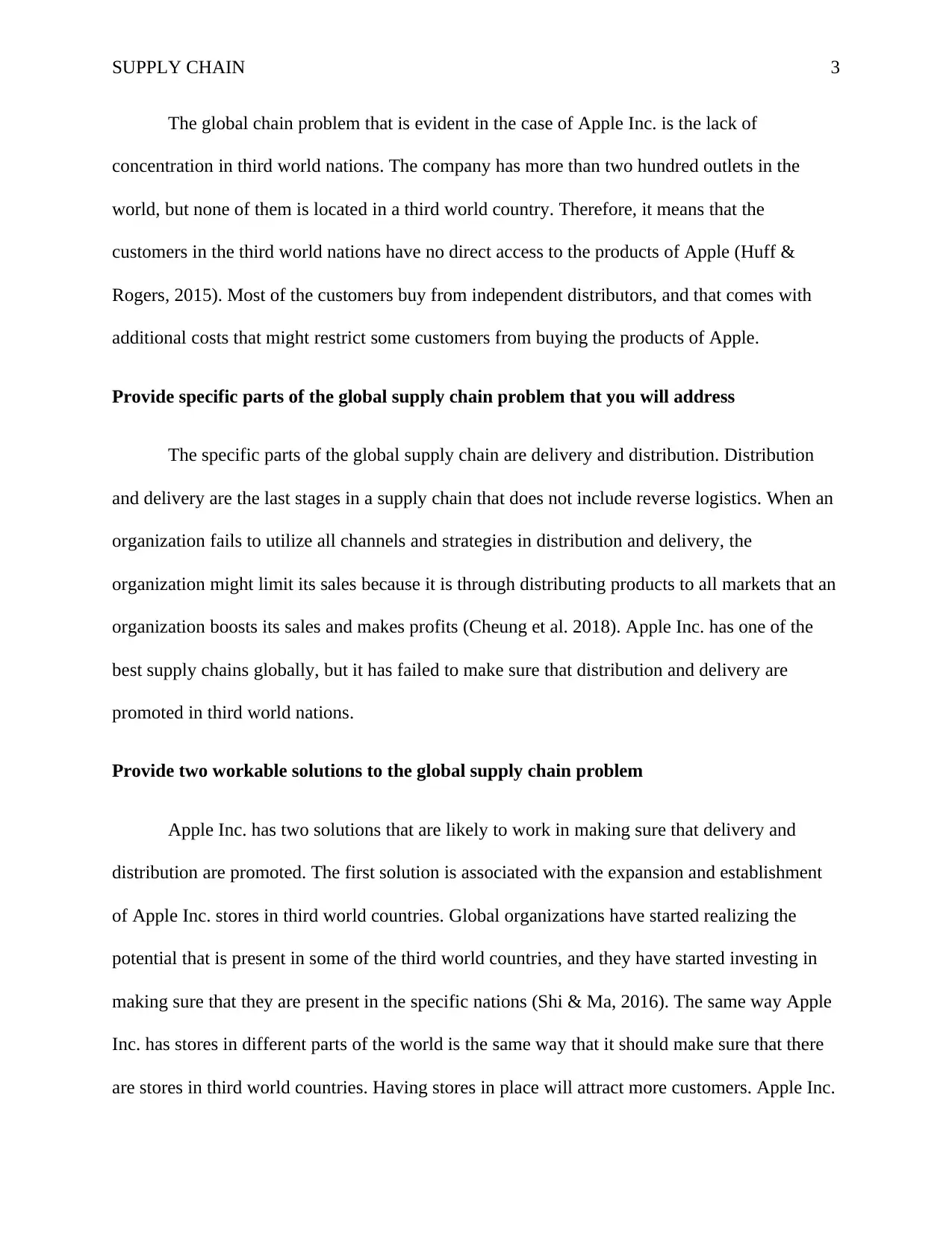
SUPPLY CHAIN 3
The global chain problem that is evident in the case of Apple Inc. is the lack of
concentration in third world nations. The company has more than two hundred outlets in the
world, but none of them is located in a third world country. Therefore, it means that the
customers in the third world nations have no direct access to the products of Apple (Huff &
Rogers, 2015). Most of the customers buy from independent distributors, and that comes with
additional costs that might restrict some customers from buying the products of Apple.
Provide specific parts of the global supply chain problem that you will address
The specific parts of the global supply chain are delivery and distribution. Distribution
and delivery are the last stages in a supply chain that does not include reverse logistics. When an
organization fails to utilize all channels and strategies in distribution and delivery, the
organization might limit its sales because it is through distributing products to all markets that an
organization boosts its sales and makes profits (Cheung et al. 2018). Apple Inc. has one of the
best supply chains globally, but it has failed to make sure that distribution and delivery are
promoted in third world nations.
Provide two workable solutions to the global supply chain problem
Apple Inc. has two solutions that are likely to work in making sure that delivery and
distribution are promoted. The first solution is associated with the expansion and establishment
of Apple Inc. stores in third world countries. Global organizations have started realizing the
potential that is present in some of the third world countries, and they have started investing in
making sure that they are present in the specific nations (Shi & Ma, 2016). The same way Apple
Inc. has stores in different parts of the world is the same way that it should make sure that there
are stores in third world countries. Having stores in place will attract more customers. Apple Inc.
The global chain problem that is evident in the case of Apple Inc. is the lack of
concentration in third world nations. The company has more than two hundred outlets in the
world, but none of them is located in a third world country. Therefore, it means that the
customers in the third world nations have no direct access to the products of Apple (Huff &
Rogers, 2015). Most of the customers buy from independent distributors, and that comes with
additional costs that might restrict some customers from buying the products of Apple.
Provide specific parts of the global supply chain problem that you will address
The specific parts of the global supply chain are delivery and distribution. Distribution
and delivery are the last stages in a supply chain that does not include reverse logistics. When an
organization fails to utilize all channels and strategies in distribution and delivery, the
organization might limit its sales because it is through distributing products to all markets that an
organization boosts its sales and makes profits (Cheung et al. 2018). Apple Inc. has one of the
best supply chains globally, but it has failed to make sure that distribution and delivery are
promoted in third world nations.
Provide two workable solutions to the global supply chain problem
Apple Inc. has two solutions that are likely to work in making sure that delivery and
distribution are promoted. The first solution is associated with the expansion and establishment
of Apple Inc. stores in third world countries. Global organizations have started realizing the
potential that is present in some of the third world countries, and they have started investing in
making sure that they are present in the specific nations (Shi & Ma, 2016). The same way Apple
Inc. has stores in different parts of the world is the same way that it should make sure that there
are stores in third world countries. Having stores in place will attract more customers. Apple Inc.
⊘ This is a preview!⊘
Do you want full access?
Subscribe today to unlock all pages.

Trusted by 1+ million students worldwide
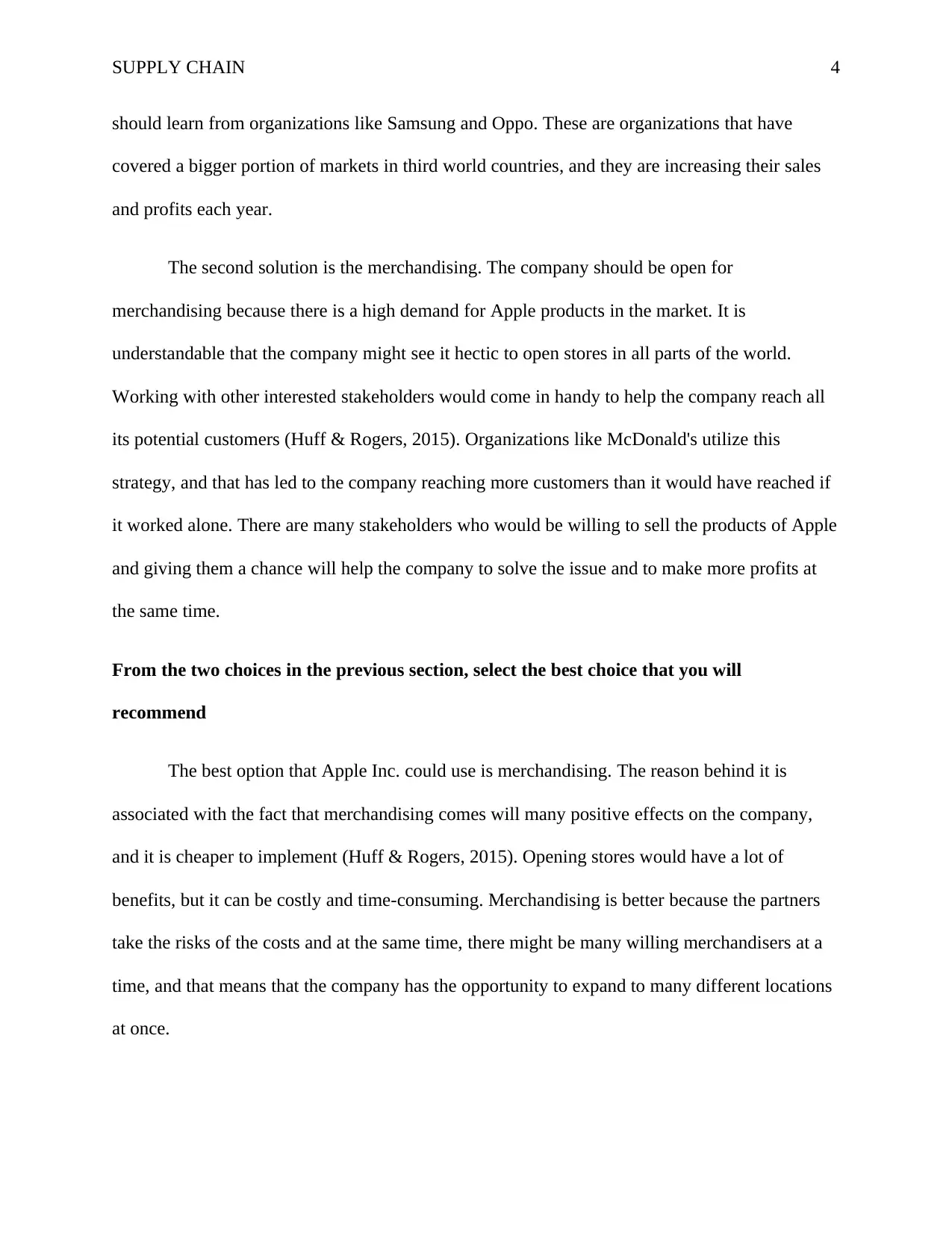
SUPPLY CHAIN 4
should learn from organizations like Samsung and Oppo. These are organizations that have
covered a bigger portion of markets in third world countries, and they are increasing their sales
and profits each year.
The second solution is the merchandising. The company should be open for
merchandising because there is a high demand for Apple products in the market. It is
understandable that the company might see it hectic to open stores in all parts of the world.
Working with other interested stakeholders would come in handy to help the company reach all
its potential customers (Huff & Rogers, 2015). Organizations like McDonald's utilize this
strategy, and that has led to the company reaching more customers than it would have reached if
it worked alone. There are many stakeholders who would be willing to sell the products of Apple
and giving them a chance will help the company to solve the issue and to make more profits at
the same time.
From the two choices in the previous section, select the best choice that you will
recommend
The best option that Apple Inc. could use is merchandising. The reason behind it is
associated with the fact that merchandising comes will many positive effects on the company,
and it is cheaper to implement (Huff & Rogers, 2015). Opening stores would have a lot of
benefits, but it can be costly and time-consuming. Merchandising is better because the partners
take the risks of the costs and at the same time, there might be many willing merchandisers at a
time, and that means that the company has the opportunity to expand to many different locations
at once.
should learn from organizations like Samsung and Oppo. These are organizations that have
covered a bigger portion of markets in third world countries, and they are increasing their sales
and profits each year.
The second solution is the merchandising. The company should be open for
merchandising because there is a high demand for Apple products in the market. It is
understandable that the company might see it hectic to open stores in all parts of the world.
Working with other interested stakeholders would come in handy to help the company reach all
its potential customers (Huff & Rogers, 2015). Organizations like McDonald's utilize this
strategy, and that has led to the company reaching more customers than it would have reached if
it worked alone. There are many stakeholders who would be willing to sell the products of Apple
and giving them a chance will help the company to solve the issue and to make more profits at
the same time.
From the two choices in the previous section, select the best choice that you will
recommend
The best option that Apple Inc. could use is merchandising. The reason behind it is
associated with the fact that merchandising comes will many positive effects on the company,
and it is cheaper to implement (Huff & Rogers, 2015). Opening stores would have a lot of
benefits, but it can be costly and time-consuming. Merchandising is better because the partners
take the risks of the costs and at the same time, there might be many willing merchandisers at a
time, and that means that the company has the opportunity to expand to many different locations
at once.
Paraphrase This Document
Need a fresh take? Get an instant paraphrase of this document with our AI Paraphraser
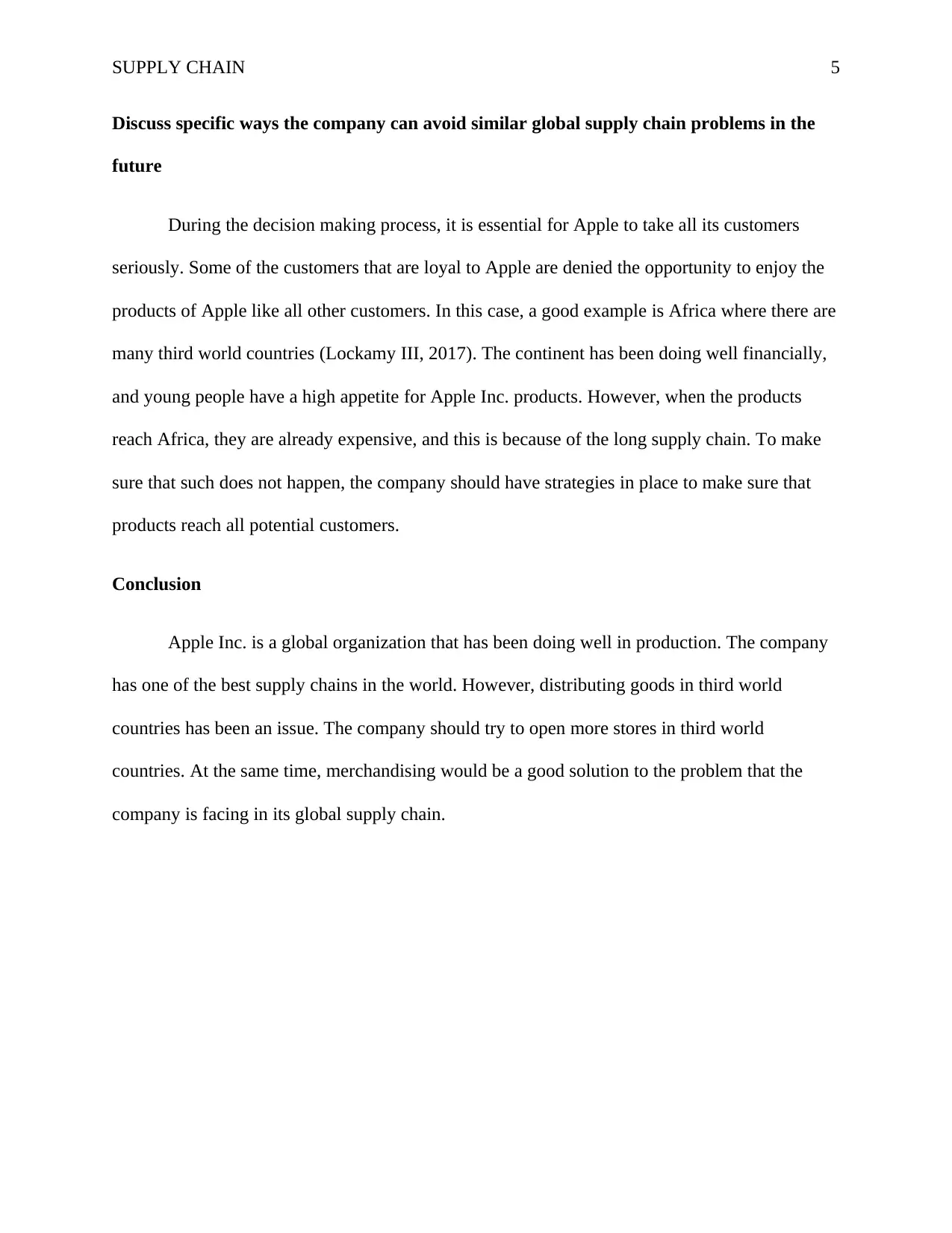
SUPPLY CHAIN 5
Discuss specific ways the company can avoid similar global supply chain problems in the
future
During the decision making process, it is essential for Apple to take all its customers
seriously. Some of the customers that are loyal to Apple are denied the opportunity to enjoy the
products of Apple like all other customers. In this case, a good example is Africa where there are
many third world countries (Lockamy III, 2017). The continent has been doing well financially,
and young people have a high appetite for Apple Inc. products. However, when the products
reach Africa, they are already expensive, and this is because of the long supply chain. To make
sure that such does not happen, the company should have strategies in place to make sure that
products reach all potential customers.
Conclusion
Apple Inc. is a global organization that has been doing well in production. The company
has one of the best supply chains in the world. However, distributing goods in third world
countries has been an issue. The company should try to open more stores in third world
countries. At the same time, merchandising would be a good solution to the problem that the
company is facing in its global supply chain.
Discuss specific ways the company can avoid similar global supply chain problems in the
future
During the decision making process, it is essential for Apple to take all its customers
seriously. Some of the customers that are loyal to Apple are denied the opportunity to enjoy the
products of Apple like all other customers. In this case, a good example is Africa where there are
many third world countries (Lockamy III, 2017). The continent has been doing well financially,
and young people have a high appetite for Apple Inc. products. However, when the products
reach Africa, they are already expensive, and this is because of the long supply chain. To make
sure that such does not happen, the company should have strategies in place to make sure that
products reach all potential customers.
Conclusion
Apple Inc. is a global organization that has been doing well in production. The company
has one of the best supply chains in the world. However, distributing goods in third world
countries has been an issue. The company should try to open more stores in third world
countries. At the same time, merchandising would be a good solution to the problem that the
company is facing in its global supply chain.
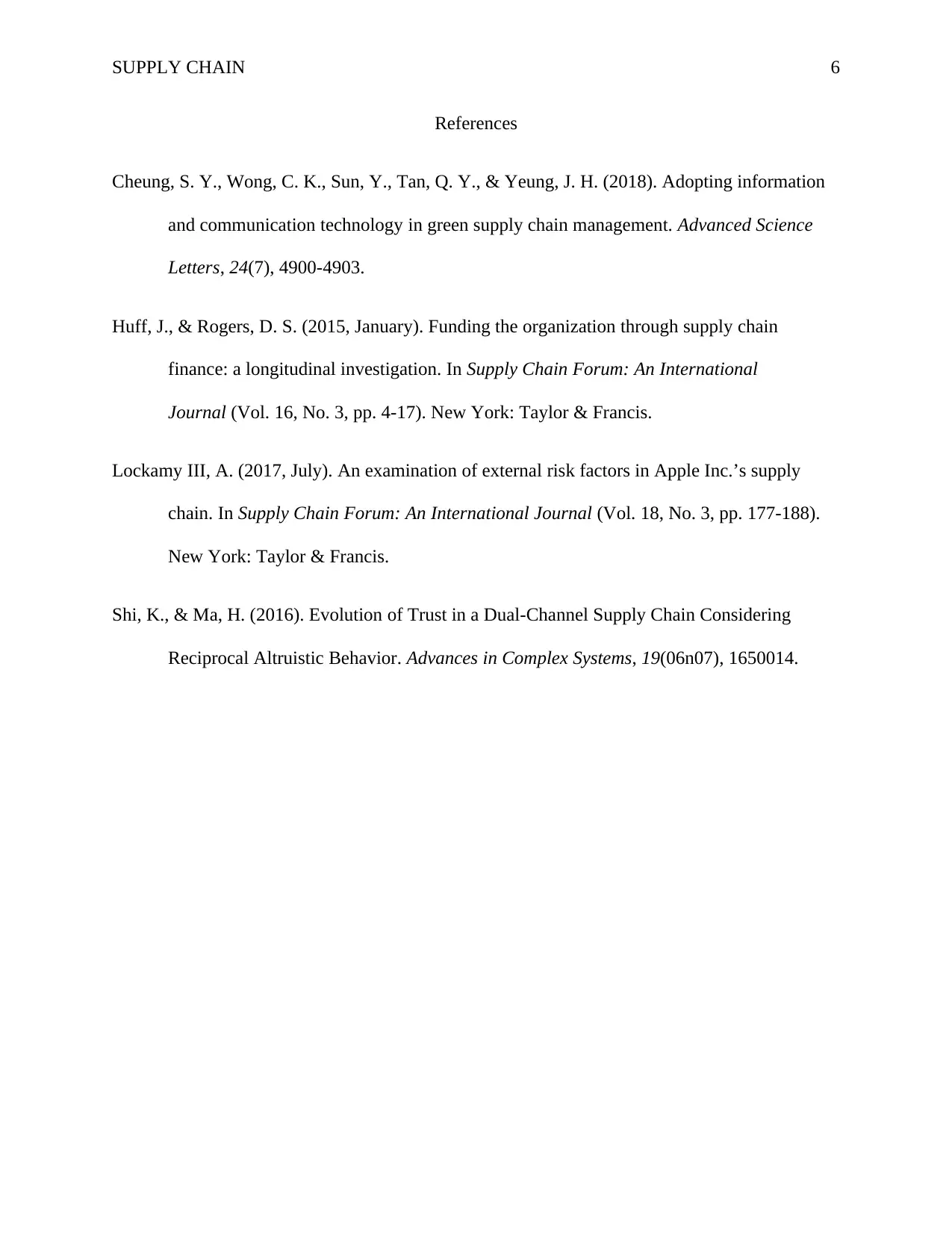
SUPPLY CHAIN 6
References
Cheung, S. Y., Wong, C. K., Sun, Y., Tan, Q. Y., & Yeung, J. H. (2018). Adopting information
and communication technology in green supply chain management. Advanced Science
Letters, 24(7), 4900-4903.
Huff, J., & Rogers, D. S. (2015, January). Funding the organization through supply chain
finance: a longitudinal investigation. In Supply Chain Forum: An International
Journal (Vol. 16, No. 3, pp. 4-17). New York: Taylor & Francis.
Lockamy III, A. (2017, July). An examination of external risk factors in Apple Inc.’s supply
chain. In Supply Chain Forum: An International Journal (Vol. 18, No. 3, pp. 177-188).
New York: Taylor & Francis.
Shi, K., & Ma, H. (2016). Evolution of Trust in a Dual-Channel Supply Chain Considering
Reciprocal Altruistic Behavior. Advances in Complex Systems, 19(06n07), 1650014.
References
Cheung, S. Y., Wong, C. K., Sun, Y., Tan, Q. Y., & Yeung, J. H. (2018). Adopting information
and communication technology in green supply chain management. Advanced Science
Letters, 24(7), 4900-4903.
Huff, J., & Rogers, D. S. (2015, January). Funding the organization through supply chain
finance: a longitudinal investigation. In Supply Chain Forum: An International
Journal (Vol. 16, No. 3, pp. 4-17). New York: Taylor & Francis.
Lockamy III, A. (2017, July). An examination of external risk factors in Apple Inc.’s supply
chain. In Supply Chain Forum: An International Journal (Vol. 18, No. 3, pp. 177-188).
New York: Taylor & Francis.
Shi, K., & Ma, H. (2016). Evolution of Trust in a Dual-Channel Supply Chain Considering
Reciprocal Altruistic Behavior. Advances in Complex Systems, 19(06n07), 1650014.
⊘ This is a preview!⊘
Do you want full access?
Subscribe today to unlock all pages.

Trusted by 1+ million students worldwide
1 out of 6
Related Documents
Your All-in-One AI-Powered Toolkit for Academic Success.
+13062052269
info@desklib.com
Available 24*7 on WhatsApp / Email
![[object Object]](/_next/static/media/star-bottom.7253800d.svg)
Unlock your academic potential
Copyright © 2020–2025 A2Z Services. All Rights Reserved. Developed and managed by ZUCOL.




